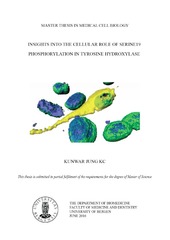Insights into the cellular role of Serine19 phosphorylation in tyrosine hydroxylase
Master thesis
Permanent lenke
https://hdl.handle.net/1956/12902Utgivelsesdato
2016-06-01Metadata
Vis full innførselSamlinger
Sammendrag
Tyrosine hydroxylase (TH) is the rate limiting enzyme that catalyzes the first step in the biosynthesis of catecholamines. The posttranslational modification of its regulatory domain controls the regulation of TH enzyme activity. Different kinases are responsible for the phosphorylation of the enzyme at Thr8, Ser19, Ser31 and Ser40 N terminal residues. It is well established that phosphorylation at Ser31 and Ser40 (THpSer31 and THpSer40, respectively) leads to an increase of TH activity. However, phosphorylation of Ser19 does not directly increase TH activity but induces its binding to the 14-3-3 protein, leading to the enhancement of TH activity through a mechanism yet not fully understood. The main goal of this work was to investigate the cellular role of Ser19 phosphorylation in TH. Site-directed mutagenesis was used to substitute Ser residue with Ala and Glu at position 19 of recombinant V5-tagged TH to create a phospho-null (V5-TH-S19A) and phospho-mimic mutant (V5-TH-S19E), respectively. Native-PAGE analysis showed that there is no significant difference in the oligomeric state of TH in nuclear and cytosolic fractions of neuroblastoma cells, regardless of the phosphorylation state of Ser19. Immunofluorescence (IF) analysis of the subcellular distribution of endogenous THpSer19 showed that it was predominantly distributed in the nucleus of neuroblastoma cells. However, Western blot results showed that the band intensity for THpSer19 in the cytosolic fraction was stronger than the band found in the nuclear fraction. Proximity ligation assay (PLA) suggested that the amount of TH present in the nucleus is phosphorylated at Ser19. Western blot and immunofluorescence analysis showed that the phospho-site mutants did not accumulate preferentially in the nucleus or in the cytosol. Both IF and PLA analysis showed that 14-3-3 proteins are distributed in the cytoplasm and nucleus of neuroblastoma cells. PLA analysis indicated that also in the nucleus THpSer19 interacts with 14-3-3 protein. These results, thus, have an impact on fundamental understanding of the distribution of THpSer19 and one of the binding partners in nucleus, such as 14-3-3γ.
